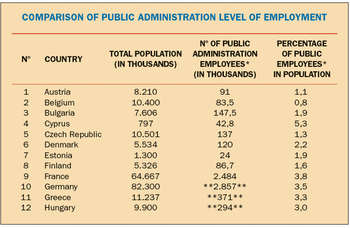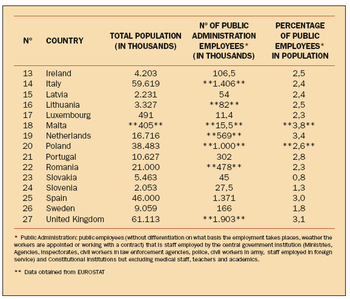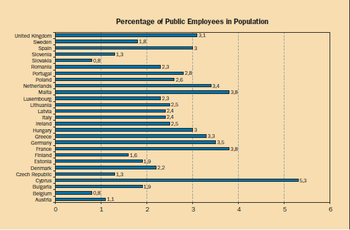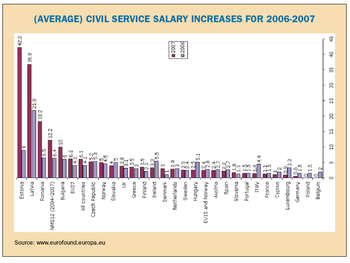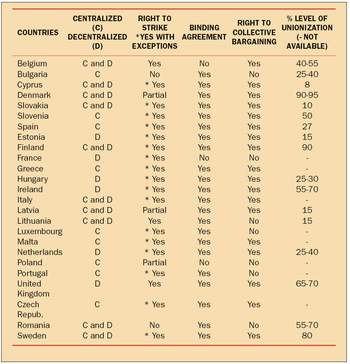Archive:Civil servants in the EU member states
This page provides an overview of all articles in Statistics Explained on public employment statistics.
Public employment statistics by country
Methodology / metadata
Overview Information is compiled in accordance with the following methodologies :
1.) EU Staff Regulations. This is the official document describing the rules, principles and working conditions of the European Civil Service. These rules are essential to guarantee the European Civil Service maintains the highest standards. As of 1 January 2014 a new version of the Staff Regulations came into force. Articles 64 and 65 and Annex XI regulate the annual adjustment of salaries: in accordance with the principle of parallelism, remuneration of EU officials evolves in line with the average evolution of remuneration of national civil servants working in central public administration in EU Member States. There are no official harmonised statistics specifically about public sector employment and public sector remuneration. In consequence, comprehensive information has to be compiled about public employment statistics in EU Member States. This is mainly required for administrative purposes, however it is also of interest for other analyses.
2.) Methodological manual on calculation of specific indicators and control indicators in accordance with Article 65 and Annex XI of the EU Staff Regulations, version June 2014. Document reference A6465/14/26rev. This manual makes use of relevant terms from various sources, including :
i.) ESA 2010 Regulation no.549/2013. Amongst other things this Regulation defines relevant terms such as "central public administration", and sets transmission timetable for delivery of GDP statistics (overall and detailed components).
ii.) LFS Regulation no.577/1998. Amongst other things this Regulation and subsequent implementing rules defines relevant terms such as "employment".
iii.) LCS&SES Regulation no.530/1999. Amongst other things this Regulation and subsequent implementing rules defines relevant terms such as "gross earnings".
iv.) SILC Regulation no.1177/2003. Amongst other things this Regulation and subsequent implementing rules defines relevant terms such as "household composition" and "net income".
v.) International Standard Classification of Occupations 2008.
vi.) Compendium of Harmonised Index of Consumer Prices legislation 2013.
3.) European Statistical Law
The European Statistical System provides policy makers as well as the general public within the European Union with high quality statistics. A basic legal framework, taking the form of a Regulation on European statistics no.223/2009 and subsequent amending and implementing rules, has been established in order to ensure the efficient functioning of the European Statistical System for that purpose.
Background articles
- Dedicated section "Remuneration statistics for administrative purposes"
- Statistics explained page "Category: Labour market"
- Statistics explained page "Living conditions statistics introduced"
- Statistics explained page "National accounts (incl.GDP)"
- Statistics Explained page "Glossary: ISCO"
- Statistics Explained page "Consumer prices"
- Eurostat website page "About Eurostat"
- Eurostat website page "Quality"
Publications
Annual reports
External publications
Administration and the Civil Service in the EU27 Member States, French Presidency Report 2007 Public employment in European Union Member States, Spanish Presidency Report 2010
Public employment statistics in general
This article provides background information about public employment statistics. In this section "public employment statistics" means information of the following types: - employee numbers in central public administration of EU Member States - gross remuneration in nominal terms of employees in central public administration of EU Member States - gross remuneration in real terms of employees in central public administration of EU Member States - net remuneration in nominal terms of employees in central public administration of EU Member States - net remuneration in real terms of employees in central public administration of EU Member States - annual evolution of remuneration of employees in central public administration of EU Member States - ancillary information about employees in central public administration of EU Member States
This information is compiled as part of the annual exercise to review the remuneration of EU officials. In accordance with the principle of parallelism set out in the Staff Regulations, the remuneration of EU officials is required to evolve either upwards or downwards in line with the average evolution of remuneration of national civil servants working in central public administration in EU Member States.
Whilst various official statistics are compiled about employment, earnings, time use, etc. there are no official harmonised statistics specifically about public sector employment and public sector remuneration. In consequence, comprehensive information has to be compiled about public employment statistics in EU Member States.
Academic study 2010
The civil services of EU Member States have evolved separately and reflect particular needs, cultures and traditions of each Member States. The following summary table is adapted from an academic study in 2010 by Christoph Demmke & Timo Moilanen from the European Institute of Public Administration ("Civil Services in the EU of 27: Reform Outcomes and the Future of the Civil Service") :
Spanish Presidency Report 2010
Context
During the Spanish Presidency of the EU in 2010, reference information was compiled about the public administrations of EU Member States and published in a report "Public employment in European Union Member States". The aim of this study is to provide a summary of the most important aspects of public employment within the community framework by means of a comparative analysis.
The Spanish Presidency report updates and expands an earlier report "Administration and the Civil service in the 27 EU Member states" prepared under the French Presidency of the EU in 2007.
The Spanish Presidency report includes a comparative overview, followed by a separate analysis for each EU27 country presented in a harmonised format. The content is not exhaustive or in-depth as this is not its purpose, but instead, it provides an introduction to public sector employment in the European Union.
This section presents extracts and tables from the comparative overview.
Regional and administrative organisation
All executive powers in the European Union are dual, the role of head of state may be exercised by the monarch, (Sweden, Denmark, Netherlands, Belgium, United Kingdom, Luxembourg and Spain), or by the president of the republic (remaining countries). Judiciary power is characterised by its homogeneity and independence compared with other powers. In all cases, legislative power lies with a parliament that may have a single chamber or two chambers.
Local Level
There are different levels of self-government and classification of local authorities, whereby the spectrum of powers varies depending on the countries. The local level plays an important role in the Nordic countries, Netherlands and United Kingdom. In any case, all EU countries have ratified the European Charter of Local Self-Government.
Public administration
The administrative organization of the EU countries has evolved from an initial bureaucratic administration through the modernization of structures, creation of agencies, specialization of duties, on-going training, the use of new technologies and the outsourcing of services.
Figure 1 summarises parliamentary systems in the EU Member States.
Figure 2 summarises regional organisation in the EU Member States.
Civil service structure
Civil servants: current situation
- Duality, in most countries between civil servants and non-civil service employees, with different legal systems and a tendency to unify the contents and working conditions of both groups.
- Their excessive temporary nature is a widespread phenomenon in both the public and private sectors.
- Problems in differentiating functions to be carried out by civil servants, non-civil service employees and by those recruited using trust criteria. The latter are usually temporary and are recruited to perform management or administrative management functions.
In general, the following types exist:
- Civil Servants
This is a heterogeneous group and is made up of all those public employees linked to a Public Administration through an act of appointment and a statutory relation which is essentially regulated by Administrative Law. The civil servant condition does not necessarily mean that they work full time in public service, but it is compatible with part-time work or, where appropriate, working from home or any other forms that may be established by the corresponding laws and according to needs.
- Non-civil service employees
Non-civil service employees serving Public Administrations and Authorities are governed by employment law but with special conditions and numbers have increased over the years. The main problem in most of the EU member states is the system to apply and uniformity of conditions in the provision of services.
- Interim/Transitory/Temporary Staff
This type of staff fills a vacancy that is not performed by a career-based civil servant. They are recruited in all Member States on the principles of merit and ability and they are freely appointed and released. Their numbers and duties differ from country to country.
- Management
Managers assume important responsibilities with high added value in most countries. Their regulatory system, responsibilities, working hours and remuneration level varies in the different civil service systems.
Staff management is vested in the government through ministries: Ministry for Public Administration (Slovenia), Home Office (Czech Republic) or Finance (Denmark) etc. Remuneration and budgetary powers affecting civil servants usually lies with the ministry responsible for finance.
Figures 3, 4, 5 and 6 compare total population and number of public administration employees in the EU Member States.
Rights, obligations and values of public employees
In terms of principles and values for public employees, many States have drawn up their own ethical Codes of Conduct, either incorporated into civil service legislation or independently.
Values
Values form part of a common axiological framework within the regulatory system of each country. Although the terms value and principle have not been sufficiently defined, most countries differentiate between both categories in their legal texts.
Common values include:
- Efficiency
Efficiency is mainly identified with the exercise of public functions and almost always depends on technical skill and experience.
- Objectivity
Most European public employment systems set out permanence, professionalism, speciality and technical preparation with legal connection in order to bring administrative action fully in line with the law and a direct relationship with public interests. One of the basic and general requirements of public administration in the EU is the necessary objectivity in the exercise of public functions.
- Technical knowledge, experience and professionalism
Along with an employment relationship and the exercising of functions to ensure impartiality, those related to the use of technical know-how are subject to objectivity, including the interpretation of public interest.
- Equality, merit and ability
There is some disparity regarding their consideration as principles or values. However, they are considered to be essential in selection systems and job performance and appointment. There is also homogeneity in the evolution of the equality value.
Rights
General legislation on public service in each State sets out a list of rights for civil servants. They are normally basic rights that are similar for all staff, regardless of whether they are career civil servants, non-civil service employees, temporary or interim staff or management. They include the right to a career, training, paid work, paid leave and holidays, effective performance of the tasks related to their professional category, objective and transparent assessment in the exercise of their functions, respect for their privacy, sexual orientation, image and category at work, work-family life balance, the freedom of expression, etc. There are other rights that are only recognised for a single category of employees such as the right to immobility and permanence, which is mainly attributed to civil servants.
Along with individual rights, there are other group rights that are recognised in the Member States analysed. The right to unionization, free professional association, collective bargaining, strike, etc. is particularly important.
Administrative career
At work, a common framework in terms of career has been detected. As far as classification and organization is concerned, the States tend to create diverse professional groups linked to entry qualifications, on one hand, and to salary bands, on the other hand. The traditional career model is vertical, whereby an employee moves up the different categories. However, there are countries that consider the possibility of promotion without changing jobs, such as the horizontal career. Finally, the career system is starting to include performance appraisal.
Figure 7 classifies EU Member State public administrations by career system.
Remuneration
The general remuneration system in the Member States responds principally to the following objectives: recruitment of good professionals; performance -related; retention of valuable professionals; increase in the level of staff satisfaction and quality of working life; strengthening of the public service culture, etc.
In the current models, the general pay increases are determined in accordance with the annual provisions of the state budgetary regulations. These set out maximum limits for pay rises in all Public Administrations. Pay in the public sector is generally lower than in the private sector, with a significant difference in the case of management and high level employees, and it increases as careers progress.
In turn, the pay system is closely linked to the career-based system mentioned in the previous paragraph. Therefore, in the States, part of the salary (base salary) is usually linked to the salary scale for the specific job performed by a certain public employee.
The rest of the pay is based on another series of criteria or bonuses that affect the pay structure of public employees. In most countries, traditional and common criteria are related to seniority although, as indicated, there are increasingly more bonuses linked to performance appraisal. Other factors, such as the employee’s family situation, overtime or working on public holidays, danger allowance, etc. are also being taken into account when establishing pay schemes. In some States (for example Denmark) salary increases are linked to those in the private sector.
For illustrative purposes, Figure 8 shows civil servant salary increases in EU Member States for 2006-2007. A time series of harmonised data compiled by Eurostat is available in Annual Remuneration Report and on Free Data Tables.
Social dialogue and representation system
Social dialogue and bargaining form part of the public employee statutory system. In collective bargaining, countries apply a different system to civil servants and non civil service employees, in accordance with the differences between both groups.
Figure 9 presents a summary of bargaining systems in public administrations of EU Member States.
Senior civil servants (SCS)
This figure is present in many EU countries, although with different characteristics and peculiarities depending on each country. It is defined by the OECD as a system of personnel for high and top level management positions in the national civil service, formally or informally recognised by an authority, or through a common understanding of the organisation of such a group.
It is a career-related development framework allowing people to be competitively appointed to functions that cover public policy advice, operational or service management.
In general, there are two types of employment system for the SCS (the career-based system and the position-based system). In the career-based system, high level civil servants share the same culture as the rest of the staff, which enables the whole workforce to work together and communication is easier, which in turn fosters internal mobility. In the position-based system, a group of candidates is selected from those with special skills by means of an open examination and they are trained with an open cultural approach so that they can adapt appropriately to working in a public organization.
Although there are significant differences between these two systems, a growing number of States have begun to combine elements of both systems (a hybrid system), as shown in Figure 10.
The main common elements of SCS employment are:
- selection is not usually based on permanent occupation of a position;
- relations with the Administration are characterised by previously agreed fixed conditions;
- their activities are subject to performance appraisal in almost all countries;
- in general SCS belong to the Administration or its external environment;
- there is a lot of mobility between public organisations and the public and private sector;
- skills and experience are important in the recruitment process;
- other skills such as leadership or future vision are valued.
Only two Member States have created a central, specialised body for the management of senior civil servants: the Ministry of the Interior in the Netherlands and the “Civil Service Capability Group” in the United Kingdom, which is dependent on the “Cabinet Office”. The remaining countries manage them through a partially centralised system (Cyprus, Lithuania, Luxembourg, Malta, Poland, Portugal and Slovakia), or a decentralised system (Austria, Belgium, Bulgaria, Czech Republic, Denmark, Estonia, Finland, Germany, Greece, Hungary, Italy, Latvia, Romania, Spain and Sweden).
Remuneration system
In 16 Member States, the salary system is regulated by law with pay bands and a specific amount of salary for each functional level or job category. In 10 Member States (Austria, France, Greece, Hungary, Italy, Latvia, Lithuania, Luxembourg and Spain) salary increases are determined by seniority or years of service in the organisation. In 16 Member States (Austria, Denmark, Finland, France, Greece, Ireland, Italy, Latvia, Lithuania, Malta, the Netherlands, Portugal, Slovakia, Slovenia, Sweden and the United Kingdom) salary levels are determined by a positive performance appraisal via increases and bonuses. In other countries, it is determined in accordance with qualifications and years of service although a positive performance appraisal may be rewarded with a performance-related bonus.
Recent reforms and prospects
As a conclusion to this study, the following measures are necessary:
- homogenise the different public employment models;
- gradually incorporate management techniques from the private sector;
- use information and communication technologies;
- facilitate mobility between public employees in the EU;
- increase information and coordination between countries in terms of public employment;
- improve employee training both quantitatively and qualitatively;
- increase the presence of women in high-level positions.
Figure 11 shows female participation in executive positions in public administration of EU Member States.
Conclusions of the Spanish Presidency Report 2010
- Due to the complex preparation of this study and the difficulties in obtaining data, in spite of the cooperation of the spokespersons of the different countries, it would be recommendable to introduce an on-going process to increase knowledge on the functioning of the public administrations in the Member States of the European Union, and the agenda of the European Public Administration Network (EUPAN).
- The civil service in a state of law is constituted as an essential tool of the system because it helps secure important political decisions, ensuring their adjustment to the law, their feasibility and effectiveness. Therefore, it is contemplated as an ad intra power of State organization, which requires an objective and impartial profession that is not subject to political conditions, extending its service in general and not just to each specific government, without detriment to a certain margin of trust and service in specific posts related to public policies or clearly political decisions. In this respect, the public management function is merely one more public function.
- The law should be an important part of the lawfulness of administrative actions and guarantor of subjective rights, so it can be considered an essential part of the legal system and administrative efficiency.
- The future of the European civil service should focus on public employee dynamism, flexibility and efficiency in order to adapt to a period of change that will affect their working methodology, highlighting the implementation of on-line administration, an issue that is pending and is absolutely necessary as a vital tool in the management of change.
- With a view to seeking the highest possible efficiency, public employees should reinforce their training, as what will characterize the public administrations of the future will be the need to use knowledge management in order to fulfil their objectives.
- Advances also need to be made to achieve gender equality in public employment (only 7 % of women hold a senior position in all of the European public administrations) through measures that seek work-life balance for public employees in Europe, promoting new working systems such as tele-working as well as the measures required so that men cooperate to a greater extent in the family and household demands.
- European administrations should promote greater cooperation, coordination and knowledge sharing between them and between public employees via the transfer of knowledge and strategies in the name of promoting the global wellbeing of European citizens. These are some of the challenges that European civil servants face to create a public administration that is objective, modern and fully adapted to the 21st century.
Eurostat inventories
Starting in 2010, in collaboration with national delegates to the Working Group on Articles 64&65, the Eurostat Remuneration Team in Unit C3 has compiled detailed inventories of national civil service remuneration systems. A timetable to finalise these country manuals for publication was agreed at the March 2015 meeting of the Working Group. The validated inventories are available as PDF attachments to the individual country pages in the Topics section.
Further Eurostat information
Publications
Dedicated section
External links
- Council of Europe - European Charter of Local Self-Government
- EUPAN - European public administration network
- European Commission - EUPAN structure and Commission's role
- OECD
- Public employment in European Union Member States - Madrid, 2010 (pdf file, 7.47 Mb)
- United Nations International Civil Service Commission



